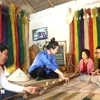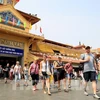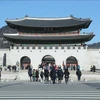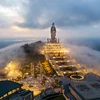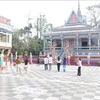The Tram Gian (hundred compartment) Pagoda nestles in the shade of centuries old pine trees in Tien Lu Village, only 20km southwest from central Hanoi . The pagoda, founded in 1185 during the reign of King Ly Cao Tong, is also known as Quang Nghiem, Tien Lu or Nui and has undergone various forms of reconstruction and restoration over time.
Legend has it that during the Tran dynasty (1225-1400) in Boi Khe Village , a woman dreamt of the Buddha's birth after which she herself fell pregnant and bore a son. Nine years later, after the deaths of his parents, the boy left home to study Buddhism at the local Dai Bi Pagoda.
At 15, while visiting Tien Lu, he fell in love with the natural beauty of the area and called on the head monk of a mountain pagoda to teach him sutras. After 10 years, the young man mastered Buddhism and became famous.
Aware of his reputation, the Tran King invited him to a pagoda in Thang Long Citadel and gave him the venerable name Duc Minh. Following the death of the head monk at Tien Lu Pagoda, Duc Minh returned to his village and built a new one. At the age of 95, the monk locked himself in a wooden chamber, saying good-bye to his disciples and freed his soul.
A 100 days later, his disciples opened the chamber, finding his scented remains which later was preserved in a tower (stupa) and worshipped as that of Saint Boi.
Recognised as a national historical relic by the culture ministry, the sacred place has attracted thousands of visitors every year thanks to its original architecture and precious collections.
"Local habitants often consider four pillars sufficient in making a compartment. Accordingly, the pagoda has a total of 104 rooms," explains Nguyen Thi Chat, head monk of the pagoda.
The pagoda includes the Gia Ngu house which overlooks a lotus pond and is used to accommodate the saintly palanquin from which the water puppet performance is viewed. Its second structure comprises blue marble steps and a two-storey bell-tower, built in 1693.
"It is known as one of the oldest bell-towers in Vietnam ," Chat said.
The tower includes eight elegantly curved corner roofs and banisters on four sides complete with cloud and floral motives. Its columns are carved with intricate lotus shapes as well as wood panels in the shapes of dragons, flowers, leaves, clouds and the sky. Below the roof hangs a copper bell cast in 1794. It is 1.4m in height, 0.6m in diameter and includes a chiselled poem by Phan Huy Ich.
The pagoda preserves a collection of 153 Buddha statues, mostly of wood except for some made of terra cotta and ceramics. The most precious among them include the Tuyet Son Buddha, carved out of black jack-tree wood, and the statue of Admiral Dang Tien Dong, a military mandarin of the Tay Son insurgent troop who contributed to the renovation of the pagoda after his victory against Qing in 1789.
A statue of Saint Boi is also preserved in a wooden room.
Other relics include a stone dragon of the Tran dynasty made as a banister, many Mac dynasty bricks used to build the Tam The statues (The Buddha of the Past, Present and Future) as well as paintings and bas-reliefs depicting animals and Arhats.
To commemorate Saint Boi, an annual festival is held at the pagoda on 4th-6th day of the first lunar month. Highlights includes a procession of the Saint's palanquin, a vegetarian cooking contest and many popular folk games such as human chess, wrestling and water puppetry.-VNA
Legend has it that during the Tran dynasty (1225-1400) in Boi Khe Village , a woman dreamt of the Buddha's birth after which she herself fell pregnant and bore a son. Nine years later, after the deaths of his parents, the boy left home to study Buddhism at the local Dai Bi Pagoda.
At 15, while visiting Tien Lu, he fell in love with the natural beauty of the area and called on the head monk of a mountain pagoda to teach him sutras. After 10 years, the young man mastered Buddhism and became famous.
Aware of his reputation, the Tran King invited him to a pagoda in Thang Long Citadel and gave him the venerable name Duc Minh. Following the death of the head monk at Tien Lu Pagoda, Duc Minh returned to his village and built a new one. At the age of 95, the monk locked himself in a wooden chamber, saying good-bye to his disciples and freed his soul.
A 100 days later, his disciples opened the chamber, finding his scented remains which later was preserved in a tower (stupa) and worshipped as that of Saint Boi.
Recognised as a national historical relic by the culture ministry, the sacred place has attracted thousands of visitors every year thanks to its original architecture and precious collections.
"Local habitants often consider four pillars sufficient in making a compartment. Accordingly, the pagoda has a total of 104 rooms," explains Nguyen Thi Chat, head monk of the pagoda.
The pagoda includes the Gia Ngu house which overlooks a lotus pond and is used to accommodate the saintly palanquin from which the water puppet performance is viewed. Its second structure comprises blue marble steps and a two-storey bell-tower, built in 1693.
"It is known as one of the oldest bell-towers in Vietnam ," Chat said.
The tower includes eight elegantly curved corner roofs and banisters on four sides complete with cloud and floral motives. Its columns are carved with intricate lotus shapes as well as wood panels in the shapes of dragons, flowers, leaves, clouds and the sky. Below the roof hangs a copper bell cast in 1794. It is 1.4m in height, 0.6m in diameter and includes a chiselled poem by Phan Huy Ich.
The pagoda preserves a collection of 153 Buddha statues, mostly of wood except for some made of terra cotta and ceramics. The most precious among them include the Tuyet Son Buddha, carved out of black jack-tree wood, and the statue of Admiral Dang Tien Dong, a military mandarin of the Tay Son insurgent troop who contributed to the renovation of the pagoda after his victory against Qing in 1789.
A statue of Saint Boi is also preserved in a wooden room.
Other relics include a stone dragon of the Tran dynasty made as a banister, many Mac dynasty bricks used to build the Tam The statues (The Buddha of the Past, Present and Future) as well as paintings and bas-reliefs depicting animals and Arhats.
To commemorate Saint Boi, an annual festival is held at the pagoda on 4th-6th day of the first lunar month. Highlights includes a procession of the Saint's palanquin, a vegetarian cooking contest and many popular folk games such as human chess, wrestling and water puppetry.-VNA
